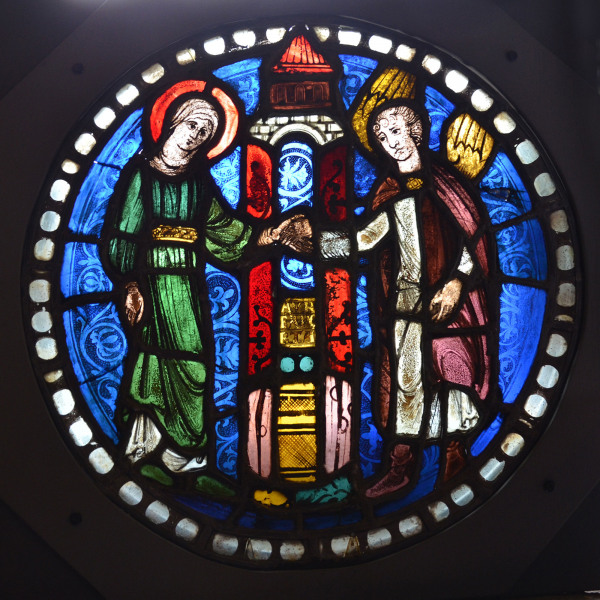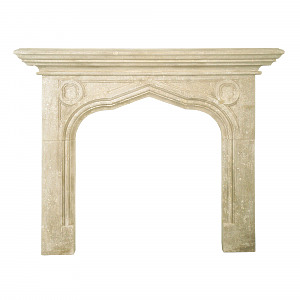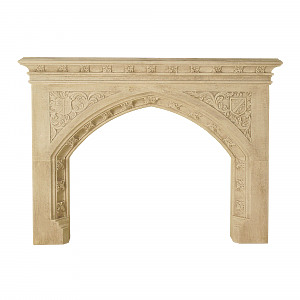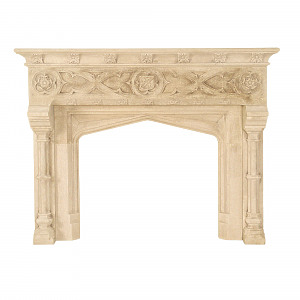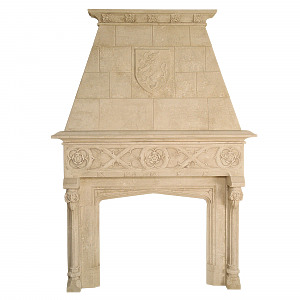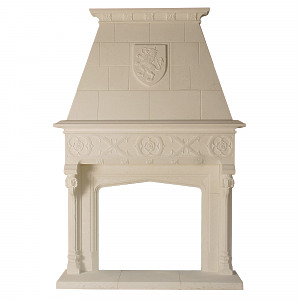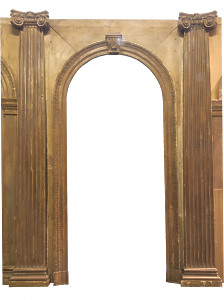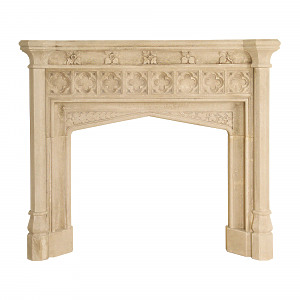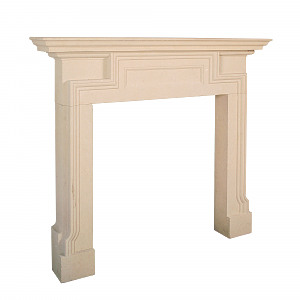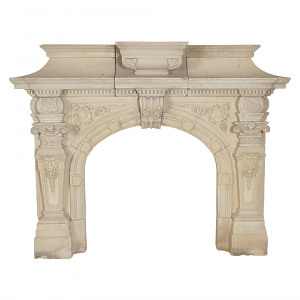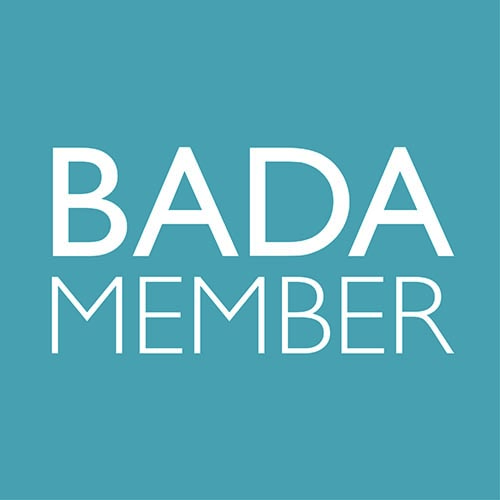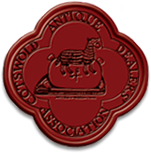A stained glass panel of 'Joachim and Anna at the Golden Gate'
A stained glass panel of 'Joachim and Anna at the Golden Gate'
Circa 1250
Stock Number: 12854
Diameter
44.00cm
[17.32 inches]
Sold
DESCRIPTION AND ICONOGRAPHY
Dr Heather Gilderdale Scott
At first sight, this circular panel, showing a veiled and nimbed female saint on the left of the scene approached by a winged figure on the right, appears to depict one of the most popular subjects in Christian art: the Annunciation by the angel Gabriel to the Virgin Mary that she will conceive and become the mother of Jesus, the Son of God. On closer inspection, however, there are a number of problems with this identification.
The panel is entirely and consistently painted and composed in a high medieval (essentially thirteenth century) style (see below for further discussion of the age and condition of the panel), yet the iconography of the panel differs notably from representations of the Annunciation dating to this period of the Middle Ages (Fig. 1). Invariably, for example, the angel Gabriel is depicted nimbed with a hand raised in a conventional speaking gesture as he addresses the Virgin. There are no known examples of Gabriel and Mary holding hands, as in this panel, nor of Gabriel wearing a cloak fastened at the neck, instead of the usual angelic costume of gown and mantle. Medieval representations of the Annunciation commonly occur within an (interior) architectural setting, often incorporating a window or locked door (referring to Mary’s purity), a prayer desk and/or a canopy (to denote the Virgin’s sanctity), but do not feature the tall tower or gate-way structure in the background of this panel. Representations of the scene very often include lilies symbolizing Mary’s virginity and spiritual purity, and an inscription beginning, ‘Ave Maria Gracia Plena’ (Hail Mary, full of grace), representing the first words spoken by Gabriel to Mary (Luke 1:26-28), both of which are absent from the panel.
Taking these elements together, it is very likely that the panel intends to depict not the Annunciation, but the apocryphal scene of the parents of the Virgin Mary, Joachim and Anna, meeting at the Golden Gate of Jerusalem, after learning that she will bear a child. Indeed, there are close parallels between the current panel and medieval representations of the scene painted in a similar style (Fig. 2), most notably the form of the red-doored gate way and the appearance and costume of the Virgin’s parents. Most tellingly, a yellow panel between the open doors of the gate, directly below the two figures’ clasped hands, is inscribed ‘AUREA PORTA’ (‘GOLDEN GATE’).
Certainly, the wings incorporated into the figure of Joachim are not consistent with any known medieval representation of Joachim, but comments below regarding the composition of the panel may indicate why the wings were introduced to the panel.
CONDITION, STYLE AND DATE
Structurally, the panel is in excellent condition: firmly and attractively housed in a grey wooden mount, it is securely and finely leaded throughout. There is no glass loss, and relatively few unrepaired cracks, although some do occur in the beaded border of the panel and also in the blue ground to the scene.
The composition is entirely legible with no patching or incongruous insertions.
The panel, in style, is essentially that of the great cathedrals of the early thirteenth-century. The circular medallion form belongs to the repertoire of geometrical shapes which together composed the elaborate narratives that filled the glazing of the period; the simple black and white beaded border is also consistent with contemporary fashion. The figure style, including the depiction of the figures’ garments, as well as the rendering of the architectural gate way are also generally in keeping with glass of this period.
Less characteristic of stained glass of the period, in which typically complex narrative compositions are set against backgrounds of plain blue or ruby glass, is the elaborate, fronded foliage design that fills the panel’s blue ground. Such complex forms are seen more frequently in glass of the fourteenth century - a very similar design is found, for example, in the background of panels in the early fourteenth-century windows of the chapel of Merton College, Oxford (fig. 3) - although there are some earlier examples, notably a panel from the mid-thirteenth century glazing of the Ste-Chapelle, now in the Cluny Museum (fig. 4) and panels narrating the Life of St Francis, dating to 1235-45, in the Barfüsserkirche, Erfurt (fig. 5) (these German examples are, however, typically associated with distinctive multi-lobed medallions, unlike the current panel’s circular form).
The panel is composed of both medieval and modern painted glass, throughout. The medieval fragments include parts of Joachim’s cloak, Anna’s gown and halo, numerous pieces of the gate, including its pink base, at least two of its red doors and its streaky ruby apex, as well as the piece of blue ground above Joachim’s left shoulder and possibly that flanking the lower part of his cloak. The yellow wings attached to Joachim are also medieval, perhaps suggesting why they were incorporated, incongruously, into the panel.
It is not clear whether the medieval portions of the panel originally belonged to a depiction of the Meeting at the Golden Gate. The yellow fragment now inscribed ‘AUREA PORTA’ may be medieval, but in medieval (Latin) texts the gate was invariably referred to as the ‘PORTA AUREA’, possibly suggesting a later painting of the piece. The outstretched arm of Gabriel and the clasped hands, whose gestures do much to indicate the subject of the panel, also do not appear to be medieval. Indeed, it is likely that the medieval portions of the composition did not originally all belong together. Joachim’s cloak, for example, contains fragments of two different purple tones, whilst the gate way has doors of both streaky and flashed ruby glass.
The modern glass used to make up the panel (including the majority of the blue ground, the figures’ heads and portions of their garments) is identifiable, primarily, either through the smooth, shiny, entirely uncorroded appearance of the glass, or through efforts made to tone done this shiny ‘glare’. Many of the pieces have been treated to create a uniformly matte surface on their reverse. The figures’ heads, and other pieces, have also had ‘corrosion’ painted on to their interior surface to suggest age. The pale, rusty-brown toned paint, applied with perfect uniformity and in perfect condition, used to depict the fronded foliage ground also marks these pieces as modern.
These various medieval and modern portions have all been handled carefully and sensitively to create a very pleasing and harmonious whole.
Dr Heather Gilderdale Scott
At first sight, this circular panel, showing a veiled and nimbed female saint on the left of the scene approached by a winged figure on the right, appears to depict one of the most popular subjects in Christian art: the Annunciation by the angel Gabriel to the Virgin Mary that she will conceive and become the mother of Jesus, the Son of God. On closer inspection, however, there are a number of problems with this identification.
The panel is entirely and consistently painted and composed in a high medieval (essentially thirteenth century) style (see below for further discussion of the age and condition of the panel), yet the iconography of the panel differs notably from representations of the Annunciation dating to this period of the Middle Ages (Fig. 1). Invariably, for example, the angel Gabriel is depicted nimbed with a hand raised in a conventional speaking gesture as he addresses the Virgin. There are no known examples of Gabriel and Mary holding hands, as in this panel, nor of Gabriel wearing a cloak fastened at the neck, instead of the usual angelic costume of gown and mantle. Medieval representations of the Annunciation commonly occur within an (interior) architectural setting, often incorporating a window or locked door (referring to Mary’s purity), a prayer desk and/or a canopy (to denote the Virgin’s sanctity), but do not feature the tall tower or gate-way structure in the background of this panel. Representations of the scene very often include lilies symbolizing Mary’s virginity and spiritual purity, and an inscription beginning, ‘Ave Maria Gracia Plena’ (Hail Mary, full of grace), representing the first words spoken by Gabriel to Mary (Luke 1:26-28), both of which are absent from the panel.
Taking these elements together, it is very likely that the panel intends to depict not the Annunciation, but the apocryphal scene of the parents of the Virgin Mary, Joachim and Anna, meeting at the Golden Gate of Jerusalem, after learning that she will bear a child. Indeed, there are close parallels between the current panel and medieval representations of the scene painted in a similar style (Fig. 2), most notably the form of the red-doored gate way and the appearance and costume of the Virgin’s parents. Most tellingly, a yellow panel between the open doors of the gate, directly below the two figures’ clasped hands, is inscribed ‘AUREA PORTA’ (‘GOLDEN GATE’).
Certainly, the wings incorporated into the figure of Joachim are not consistent with any known medieval representation of Joachim, but comments below regarding the composition of the panel may indicate why the wings were introduced to the panel.
CONDITION, STYLE AND DATE
Structurally, the panel is in excellent condition: firmly and attractively housed in a grey wooden mount, it is securely and finely leaded throughout. There is no glass loss, and relatively few unrepaired cracks, although some do occur in the beaded border of the panel and also in the blue ground to the scene.
The composition is entirely legible with no patching or incongruous insertions.
The panel, in style, is essentially that of the great cathedrals of the early thirteenth-century. The circular medallion form belongs to the repertoire of geometrical shapes which together composed the elaborate narratives that filled the glazing of the period; the simple black and white beaded border is also consistent with contemporary fashion. The figure style, including the depiction of the figures’ garments, as well as the rendering of the architectural gate way are also generally in keeping with glass of this period.
Less characteristic of stained glass of the period, in which typically complex narrative compositions are set against backgrounds of plain blue or ruby glass, is the elaborate, fronded foliage design that fills the panel’s blue ground. Such complex forms are seen more frequently in glass of the fourteenth century - a very similar design is found, for example, in the background of panels in the early fourteenth-century windows of the chapel of Merton College, Oxford (fig. 3) - although there are some earlier examples, notably a panel from the mid-thirteenth century glazing of the Ste-Chapelle, now in the Cluny Museum (fig. 4) and panels narrating the Life of St Francis, dating to 1235-45, in the Barfüsserkirche, Erfurt (fig. 5) (these German examples are, however, typically associated with distinctive multi-lobed medallions, unlike the current panel’s circular form).
The panel is composed of both medieval and modern painted glass, throughout. The medieval fragments include parts of Joachim’s cloak, Anna’s gown and halo, numerous pieces of the gate, including its pink base, at least two of its red doors and its streaky ruby apex, as well as the piece of blue ground above Joachim’s left shoulder and possibly that flanking the lower part of his cloak. The yellow wings attached to Joachim are also medieval, perhaps suggesting why they were incorporated, incongruously, into the panel.
It is not clear whether the medieval portions of the panel originally belonged to a depiction of the Meeting at the Golden Gate. The yellow fragment now inscribed ‘AUREA PORTA’ may be medieval, but in medieval (Latin) texts the gate was invariably referred to as the ‘PORTA AUREA’, possibly suggesting a later painting of the piece. The outstretched arm of Gabriel and the clasped hands, whose gestures do much to indicate the subject of the panel, also do not appear to be medieval. Indeed, it is likely that the medieval portions of the composition did not originally all belong together. Joachim’s cloak, for example, contains fragments of two different purple tones, whilst the gate way has doors of both streaky and flashed ruby glass.
The modern glass used to make up the panel (including the majority of the blue ground, the figures’ heads and portions of their garments) is identifiable, primarily, either through the smooth, shiny, entirely uncorroded appearance of the glass, or through efforts made to tone done this shiny ‘glare’. Many of the pieces have been treated to create a uniformly matte surface on their reverse. The figures’ heads, and other pieces, have also had ‘corrosion’ painted on to their interior surface to suggest age. The pale, rusty-brown toned paint, applied with perfect uniformity and in perfect condition, used to depict the fronded foliage ground also marks these pieces as modern.
These various medieval and modern portions have all been handled carefully and sensitively to create a very pleasing and harmonious whole.




